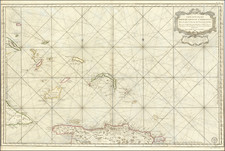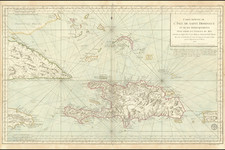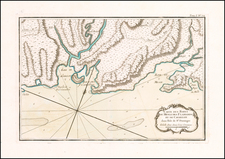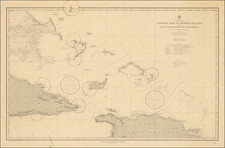The First Official Map of Hispaniola. Perhaps the Most Important Endogenous Map of Hispaniola. With the Dominican Republic-Haiti Border Under Dispute.
Large wall map of Hispaniola, covering the Dominican Republic and Haiti. The map has insets of Port-au-Prince and Santo Domingo, and explanatory keys in French and Spanish.
General Casimiro Nemesio de Moya (1849-1915) was responsible for the cartography. He was an important Dominican figure at the time, having been a guerilla military leader, politician, as well as historian, geographer and surveyor. Moya was the author of several books, but this map is his greatest accomplishment. As this was the first official map of Hispaniola, it is fair to call it the most important piece of domestic cartography ever made by someone from Hispaniola. Moya began work on the map in 1900 during his political exile in St. Thomas. It had been adopted by the National Dominican Congress on May 18, 1905.
The map was published by Rand McNally in Chicago, London, and Havana in 1906.
Dominican Republic-Haiti Border
The border between the Dominican Republic (historically Spanish) and Haiti (historically French) has shifted numerous times over the centuries. This map was published before the border was officially settled between 1929 and 1936. This map pays particular attention to that issue, noting the border as it was after the Treaty of Aranjuez in 1777, the border as it was peacefully occupied by Haiti from 1868 to 1874, the border was it was demarcated by the ad hoc Commission in 1901, and the status quo border after the armistice of 1856.
Rarity
OCLC locates four examples (six are shown, of which two are internet-only copies) at Cornell, NYPL, University of Kansas, and AGS.
Rand McNally & Co. is a large American map and navigation company best known for its annual atlases. The company got its start in 1856, when William Rand opened a print shop in Chicago. He was joined in 1858 by a new employee, Andrew McNally. Together, the men established their namesake company in 1868. Originally, the company was intended to print the tickets and timetables for the trains running to and through Chicago; their first railway guide was published in 1869.
By 1870, they had shifted from just printing to publishing directories, travel guides, and newspapers. Their first map appeared in 1872 in a railway guide. The map was produced using a new wax engraving method, a cheaper process that gave the company an edge.
By 1880 Rand McNally had entered the education market with globes, wall maps, and geography texts for students. In 1923, Rand McNally published the first Goode’s World Atlas, named after its editor, Dr. J. Paul Goode. For generations afterward, this would be the standard classroom atlas.
In 1899, William Rand left the company, but McNally and his family remained, controlling the company for over a century. In 1904, they published their first road map intended for automobiles and by 1907 were publishing Photo-Auto Guides, which combined photography and mapping to help drivers. In 1924, they produced the Auto Chum, a precursor to their famous road atlases. Rand McNally would remain the leader in road maps and atlases throughout the twentieth century.
In 1937, Rand McNally opened its first store in New York City. Ever on the frontier of technology, Rand McNally pioneered the scribing process for printing tickets in 1958 and printed their first full-color road atlas in 1960. Arthur Robinson developed his now-famous projection of Rand McNally in 1969. By the 1980s, the company was exploring digital reproduction and digital databases of maps for truckers. In the 1990s, they lead the charge to develop trip-planning software and websites. Today, most of its products are available online or in a digital format, including maps for tablets and phones.















![[Turks & Caicos, Bahamas, Hispaniola and Cuba]. Carte Reduite Des Debouquements, De St. Domingue, Levee, Dressee et Publiee par Ordre du Roi . . . 1787](https://storage.googleapis.com/raremaps/img/small/83475.jpg)
